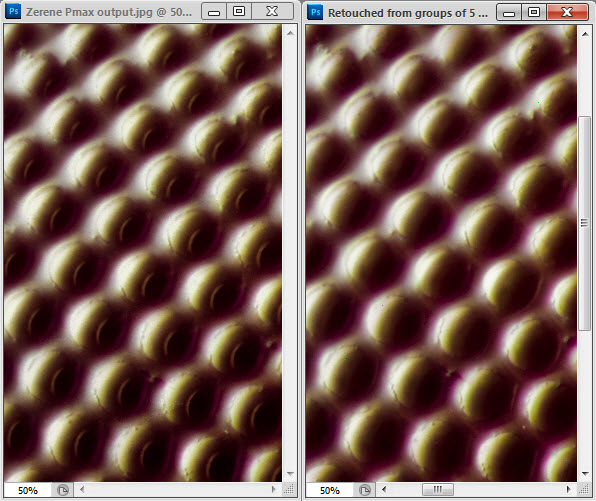seta666 wrote:Both these stacks have been very hard to deal with, both for me an ZS. The eye cell produce internal reflections as you do the shots for the stack, making the final stack very messy.
I had to retouch the whole eye area on both shots from partial stacks
Thank you for sending me the images by email. I think I understand now what you are talking about.
This is an interesting technique. Let me try to explain for other readers. Please correct me if I get it wrong.
Take a close look at the second image, the fly eye.
Question: what common feature do you NOT see?
Answer: the front of the objective!
Shiny surfaces such as this fly's eye always reflect an image of their surroundings. For example, in
"Eye of fruit fly", every ommatidium reflects several surrounding bristles. When a surface happens to face the camera, the camera sees its own lens. In "Eye of fruit fly", this occurs for each ommatidium at lower left.
We are used to seeing such reflections in focus-stacked images.
But when you are looking through a microscope, usually you will not notice the reflections.
Why is this?
It is because the reflected images do not lie at the same depth as the reflecting surface. If the reflecting surface is convex, as with ommatidia, the reflected image appears to lie a short distance
below the surface, even though it is formed by reflection
at the surface. In any case, when the lens is focused on the surface, the reflection is out of focus.
What seta666 has done here is to use the difference in focus depth to remove in-focus reflections, leaving only out-of-focus reflections that look like a soft edged diffuser on the lighting.
The technique involves a lot of retouching. Basically seta666 processes the stack in shallow slabs, something like 5 frames per slab. Each slab is thick enough to capture surface detail from some ommatidia, while not capturing in-focus reflections for those same ommatidia. Then he uses retouching to build a final image that shows the surface but not the reflections. The process is a lot of work but produces a nice result.
With kind permission from seta666, here is an illustration of the results before and after retouching.
--Rik









